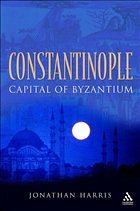This book examines the intriguing interaction between the spiritual and the political, the mythical and the actual and reconstructs the awe-inspiring city in its heyday in 1200.
During the early Middle Ages, travellers to the East returned with stories of a place called Miklagarth, a city so vast that its churches, palaces and monasteries covered the land and so rich that its ruler could scatter bagfuls of gold among his astonished guests. This was no legend or tall tale for Miklagarth was a real place. Better known as Constantinople, it was the capital city of the empire of Byzantium and a major political force in the eastern Mediterranean for over a thousand years. The mythical aura that surrounded Constantinople was no accident. It was assiduously cultivated by the Byzantine emperors to bolster their power, wealth and prestige. Jonathan Harris examines the intriguing interaction between the spiritual and the political, the mythical and the actual and reconstructs the awe-inspiring city in its heyday in 1200.
Table of contents:
Illustrations
Acknowledgements
Abbreviations
Introduction
1. The City of Wonders
2. Founding Fathers
3. Defence
4. Palaces and Power
5. Churches and Monas
Review:
"It is a tribute to Harris's skill as a writer that his book produces in the reader a sense of loss. Wisely, Harris does not attempt to give us an exhaustive history of Constantinople; instead he concentrates on the city as it was in 1200 C.E. The year is not a random choice. In 1204, a Crusader army sacked the city, triggering its descent into depopulation and ruin. But the city that the Crusaders despoiled was unsurpassed in its splendor. For centuries, Roman emperors and courtiers underwrote grand projects, constructing magnificently adorned buildings. Harris describes the physical highlights of the city, and from there launches brief expositions into politics, religion, and trade. The layout and decor of the Byzantine imperial palace, for example, leads to an exploration of dynastic politics; an examination of religious beliefs follows a description of the city's churches. Harris concludes with a brief overview of Constantinople's last years as the Byzantine capital up to its fall to an Ottoman Turkish army in 1453. A readable, informative, and vivid book, offering an evocative picture of the city in the context of the culture that produced it. Highly recommended." -Library Journal
During the early Middle Ages, travellers to the East returned with stories of a place called Miklagarth, a city so vast that its churches, palaces and monasteries covered the land and so rich that its ruler could scatter bagfuls of gold among his astonished guests. This was no legend or tall tale for Miklagarth was a real place. Better known as Constantinople, it was the capital city of the empire of Byzantium and a major political force in the eastern Mediterranean for over a thousand years. The mythical aura that surrounded Constantinople was no accident. It was assiduously cultivated by the Byzantine emperors to bolster their power, wealth and prestige. Jonathan Harris examines the intriguing interaction between the spiritual and the political, the mythical and the actual and reconstructs the awe-inspiring city in its heyday in 1200.
Table of contents:
Illustrations
Acknowledgements
Abbreviations
Introduction
1. The City of Wonders
2. Founding Fathers
3. Defence
4. Palaces and Power
5. Churches and Monas
Review:
"It is a tribute to Harris's skill as a writer that his book produces in the reader a sense of loss. Wisely, Harris does not attempt to give us an exhaustive history of Constantinople; instead he concentrates on the city as it was in 1200 C.E. The year is not a random choice. In 1204, a Crusader army sacked the city, triggering its descent into depopulation and ruin. But the city that the Crusaders despoiled was unsurpassed in its splendor. For centuries, Roman emperors and courtiers underwrote grand projects, constructing magnificently adorned buildings. Harris describes the physical highlights of the city, and from there launches brief expositions into politics, religion, and trade. The layout and decor of the Byzantine imperial palace, for example, leads to an exploration of dynastic politics; an examination of religious beliefs follows a description of the city's churches. Harris concludes with a brief overview of Constantinople's last years as the Byzantine capital up to its fall to an Ottoman Turkish army in 1453. A readable, informative, and vivid book, offering an evocative picture of the city in the context of the culture that produced it. Highly recommended." -Library Journal
